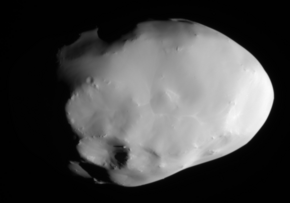Telesto /təˈlɛstoʊ/ is a moon of Saturn. It was discovered by Smith, Reitsema, Larson and Fountain in 1980 from ground-based observations, and was provisionally designated S/1980 S 13.[4] In the following months, several other apparitions were observed: S/1980 S 24,[5] S/1980 S 33,[6] and S/1981 S 1.[7]
 Telesto as seen by the Cassini probe on 11 October 2005 | |
| Discovery | |
|---|---|
| Discovered by |
|
| Discovery date | April 8, 1980 |
| Designations | |
Designation | Saturn XIII |
| Pronunciation | /təˈlɛstoʊ/ |
Named after | Τελεστώ Telestō |
| Tethys B S/1980 S 13 | |
| Adjectives | Telestoan /tɛləˈstoʊ.ən/ or Telestoian /tɛləˈstoʊ.iən/ |
| Orbital characteristics | |
| 295000 km[1] | |
| Eccentricity | 0.001[1] |
| 1.887802 d[1] | |
| Inclination | 1.19° (to Saturn's equator) |
| Satellite of | Saturn |
| Group | L4 Tethys trojan |
| Physical characteristics | |
| Dimensions | 33.2 × 23.4 × 19.2 km (± 0.6 × 0.6 × 0.4 km)[2]: 2 |
Mean diameter | 24.6±0.6 km[2]: 2 |
| Volume | 7795 km3[a] |
| Mass | ≈ 4×1015 kg (assumed; unmeasured)[b] |
Mean density | ≈ 0.5 g/cm3 (assumed; unmeasured)[2]: 3 |
| ≈ 0.0011–0.0014 m/s2[2]: 3 | |
| ≈ 0.006 km/s at longest axis to ≈ 0.007 km/s at poles | |
| zero | |
| 18.7[3] | |
In 1983 it was officially named after Telesto of Greek mythology.[c] It is also designated as Saturn XIII or Tethys B.
Telesto is co-orbital with Tethys, residing in Tethys' leading Lagrangian point (L4). This relationship was first identified by Seidelmann et al. in 1981.[8] Another moon, Calypso, resides in the other (trailing) Lagrangian point of Tethys, 60 degrees in the other direction from Tethys. The Saturnian system has two additional trojan moons.
Exploration
The Cassini probe performed a distant flyby of Telesto on October 11, 2005. The resulting images show that its surface is surprisingly smooth, devoid of small impact craters.
Notes
References
Citations
Sources
- Hamilton, Calvin J. "Saturn's Trojan Moon Telesto". SolarViews.com. SolarViews. Retrieved 2011-12-23.
- Marsden, Brian G. (April 10, 1980). "Satellites of Saturn" (discovery). IAU Circular. 3466. Retrieved 2011-12-23.
- Marsden, Brian G. (June 6, 1980). "Satellites of Saturn". IAU Circular. 3484. Retrieved 2011-12-23.
- Marsden, Brian G. (April 16, 1981). "Satellites of Saturn". IAU Circular. 3593. Retrieved 2011-12-23.
- Marsden, Brian G. (May 18, 1981). "Satellites of Saturn". IAU Circular. 3605. Retrieved 2011-12-23.
- Marsden, Brian G. (September 30, 1983). "Satellites of Jupiter and Saturn". IAU Circular. 3872. Retrieved 2011-12-23.
- Seidelmann, P. K.; Harrington, R. S.; Pascu, D.; Baum, W. A.; Currie, D. G.; Westphal, J. A.; Danielson, G. E. (1981). "Saturn satellite observations and orbits from the 1980 ring plane crossing". Icarus. 47 (2): 282. Bibcode:1981Icar...47..282S. doi:10.1016/0019-1035(81)90172-X.
- Thomas, P. C. (July 2010). "Sizes, shapes, and derived properties of the saturnian satellites after the Cassini nominal mission" (PDF). Icarus. 208 (1): 395–401. Bibcode:2010Icar..208..395T. doi:10.1016/j.icarus.2010.01.025. Archived from the original (PDF) on 2011-09-27. Retrieved 2015-09-04.
- Thomas, P. C.; Helfenstein, P. (July 2020). "The small inner satellites of Saturn: Shapes, structures and some implications". Icarus. 344: 20. Bibcode:2020Icar..34413355T. doi:10.1016/j.icarus.2019.06.016. S2CID 197474587. 113355.
External links
